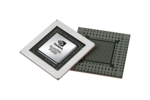NVIDIA Quadro T2000 (Laptop) vs NVIDIA Quadro P5000 Max-Q
NVIDIA Quadro T2000 (Laptop)
► remove from comparisonThe Nvidia Quadro T2000 for laptops is a professional mobile graphics card that is based on the Turing architecture (TU117 chip). It is based on the consumer desktop GTX 1650 Ti with comparable clock speeds and therefore currently between a mobile GTX 1650 and GTX 1660 Ti. The chip is manufactured in 12nm FinFET at TSMC.
The GPU features 1024 shaders, 64 texture mapping units and 32 ROPs. The 4 GB GDDR5 memory is connected with a 128-bit memory interface and clocked at 2000 MHz. At a TGP of 60W, the clock speeds are specified from 1575 MHz (base) to 1785 MHz (boost).
The Turing generation did not only introduce raytracing for the RTX cards, but also optimized the architecture of the cores and caches. According to Nvidia the CUDA cores offer now a concurrent execution of floating point and integer operations for increased performance in compute-heavy workloads of modern games. Furthermore, the caches were reworked (new unified memory architecture with twice the cache compared to Pascal). This leads to up to 50% more instructions per clock and a 40% more power efficient usage compared to Pascal. In contrary to the faster Quadro RTX cards (e.g. Quadro RTX 3000), the T1000 and T2000 don not feature raytracing and Tensor cores.
NVIDIA Quadro P5000 Max-Q
► remove from comparison
The Nvidia Quadro P5000 Max-Q (official Nvidia Quadro P5000 with Max-Q Design) is a mobile high-end workstation graphics card for notebooks. It is the power efficient variant of the normal Quadro P5000 for laptops and offers slightly reduced clock speeds (1101 - 1366 MHz versus 1164 - 1506 MHz) and a greatly reduced power consumption (80 versus 100 Watt TGP). Similar to the consumer GeForce GTX 1070 Max-Q (Laptop), it is based on a slimmed-down GP104 chip with 2048 shaders. The graphics card is designed for the Kaby Lake generation.
The Quadro GPUs offer certified drivers, which are optimized for stability and performance in professional applications (CAD, DCC, medical, prospection, and visualizing applications). The performance in these areas is therefore much better compared to corresponding consumer GPUs.
Performance
The theoretical performance should be slightly below the normal Quadro P4000 due to the reduced clock speeds.
Power Consumption
With an TGP of 80 Watt, the P5000 Max-Q is only slightly higher rated (5 Watt) as the much slower Quadro P3000 (75 Watt) and therefore similar sized laptops can use the P5000 Max-Q.
| NVIDIA Quadro T2000 (Laptop) | NVIDIA Quadro P5000 Max-Q | ||||||||||||||||||||||||||||||||||||||||||||||||||||||||||||||||||||||||||||||||||||||||
| Quadro P Series |
|
| |||||||||||||||||||||||||||||||||||||||||||||||||||||||||||||||||||||||||||||||||||||||
| Codename | N19P-Q3 | N17E-Q5 Max-Q | |||||||||||||||||||||||||||||||||||||||||||||||||||||||||||||||||||||||||||||||||||||||
| Architecture | Turing | Pascal | |||||||||||||||||||||||||||||||||||||||||||||||||||||||||||||||||||||||||||||||||||||||
| Pipelines | 1024 - unified | 2048 - unified | |||||||||||||||||||||||||||||||||||||||||||||||||||||||||||||||||||||||||||||||||||||||
| Core Speed | 1575 - 1785 (Boost) MHz | 1101 - 1366 (Boost) MHz | |||||||||||||||||||||||||||||||||||||||||||||||||||||||||||||||||||||||||||||||||||||||
| Memory Speed | 8000 MHz | 6006 MHz | |||||||||||||||||||||||||||||||||||||||||||||||||||||||||||||||||||||||||||||||||||||||
| Memory Bus Width | 128 Bit | 256 Bit | |||||||||||||||||||||||||||||||||||||||||||||||||||||||||||||||||||||||||||||||||||||||
| Memory Type | GDDR5 | GDDR5 | |||||||||||||||||||||||||||||||||||||||||||||||||||||||||||||||||||||||||||||||||||||||
| Max. Amount of Memory | 4 GB | 16 GB | |||||||||||||||||||||||||||||||||||||||||||||||||||||||||||||||||||||||||||||||||||||||
| Shared Memory | no | no | |||||||||||||||||||||||||||||||||||||||||||||||||||||||||||||||||||||||||||||||||||||||
| API | DirectX 12_1, OpenGL 4.6 | DirectX 12_1, Shader 5.0, OpenGL 4.5 | |||||||||||||||||||||||||||||||||||||||||||||||||||||||||||||||||||||||||||||||||||||||
| Power Consumption | 60 Watt | 100 Watt | |||||||||||||||||||||||||||||||||||||||||||||||||||||||||||||||||||||||||||||||||||||||
| Transistors | 4.7 Billion | ||||||||||||||||||||||||||||||||||||||||||||||||||||||||||||||||||||||||||||||||||||||||
| technology | 12 nm | 16 nm | |||||||||||||||||||||||||||||||||||||||||||||||||||||||||||||||||||||||||||||||||||||||
| Notebook Size | medium sized | large | |||||||||||||||||||||||||||||||||||||||||||||||||||||||||||||||||||||||||||||||||||||||
| Date of Announcement | 27.05.2019 | 11.01.2017 | |||||||||||||||||||||||||||||||||||||||||||||||||||||||||||||||||||||||||||||||||||||||
| Features | Optimus, PhysX, 3D Vision Pro, nView, Optimus | ||||||||||||||||||||||||||||||||||||||||||||||||||||||||||||||||||||||||||||||||||||||||
| Link to Manufacturer Page | www.nvidia.com |


 Deutsch
Deutsch English
English Español
Español Français
Français Italiano
Italiano Nederlands
Nederlands Polski
Polski Português
Português Русский
Русский Türkçe
Türkçe Svenska
Svenska Chinese
Chinese Magyar
Magyar